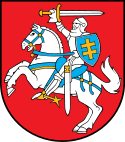- Constitutional Court of Lithuania
-
Lithuania 
This article is part of the series:
Politics and government of
Lithuania- Constitution
- Constitutional Court
Government- President
- Prime Minister
Legislature- Seimas
- Speaker of the Seimas
ElectionsSubdivisionsForeign policy- Foreign relations
- Ministers of Foreign Affairs
- Politics of the EU
The Constitutional Court of the Republic of Lithuania (in Lithuanian: Lietuvos Respublikos Konstitucinis Teismas) is a special court established by the Constitution of the Republic of Lithuania of 1992; it began the activities after the adoption of the Law on Constitutional Court of the Republic of Lithuania on February 3, 1993. Since its inception, the Court has been located in the city of Vilnius, Gediminas Avenue.
The main task of the court is judicial review. It may therefore declare the acts of the Seimas unconstitutional and thus render them ineffective. As such, it is somewhat similar to the Supreme Court of the United States. However, it differs from it and other supreme courts in that it is not part of the regular judicial system, but more a unique judicial branch. Most importantly, it does not serve as a regular court of appeals from lower courts or as a sort of “superappellate court” on any violation of national laws.
 The Court's palace in the Gediminas Avenue
The Court's palace in the Gediminas Avenue
Its jurisdiction is focused on constitutional issues, the integrity of the Constitution. Moreover, it adjudicates on the conformance of the acts of the Government of the Republic of Lithuania to the laws, compliance with the Constitution of international agreements, as well as their ratification, and takes a final decision on voting infringements.
Contents
Activities
The Court has played a substantial role in the development of the Lithuanian legal system, declaring a number of national laws unconstitutional. On March 31, 2004, it issued a ruling acknowledging the breach of the oath of office by the President Rolandas Paksas. He was removed from office by Seimas following the impeachment on April 6, 2004; this has been the first successful case of impeachment of the head of state in the history of Europe.[1] The ruling interpreted the Constitution as precluding a person, who was pleaded guilty for the breach of oath, from assuming any future position in public service, which requires taking an oath.
Composition
The Court comprises nine justices, elected by the Seimas, for a nine-year non-renewable term of office. Only Lithuanian citizens of an impeccable reputation, who are trained in law, and who have served for at least 10 years in the legal profession, or in an area of legal education are eligible for appointment. Usually, notable legal scholars and highly experienced judges qualify for the position. The candidates are nominated by the Chairman of the Seimas, the President of Lithuania and the President of the Supreme Court of the Republic of Lithuania, 3 persons each. The Seimas appoints the President of the Court from among the justices upon the nomination by the President of the state.
Members
Justices in the new 2008 term are: Kęstutis Lapinskas (President of the Court); Armanas Abramavičius; Toma Birmontienė; Pranas Kuncionis; Zenonas Namavičius; Ramutė Ruškytė; Egidijus Šileikis; Algirdas Taminskas; Romualdas Kęstutis Urbaitis.
Historical composition
1993–1996
- Juozas Žilys (President)
- Algirdas Gailiūnas
- Kęstutis Lapinskas
- Zigmas Levickis
- Vladas Pavilonis († 2003)
- Pranas Vytautas Rasimavičius († 2002)
- Teodora Staugaitienė
- Stasys Stačiokas
- Stasys Šedbaras.
1996–1999
- Juozas Žilys (President)
- Egidijus Jarašiūnas
- Kęstutis Lapinskas
- Zigmas Levickis
- Augustinas Normantas
- Vladas Pavilonis (†2003)
- Jonas Prapiestis
- Pranas Vytautas Rasimavičius (†2002)
- Teodora Staugaitienė
1999–2002
- Vladas Pavilonis (President) (†2003)
- Egidijus Jarašiūnas
- Egidijus Kūris
- Zigmas Levickis
- Augustinas Normantas
- Jonas Prapiestis
- Vytautas Sinkevičius
- Stasys Stačiokas
- Teodora Staugaitienė
2002–2005
- Egidijus Kūris (President)
- Armanas Abramavičius
- Egidijus Jarašiūnas
- Kęstutis Lapinskas
- Zenonas Namavičius
- Augustinas Normantas
- Jonas Prapiestis
- Vytautas Sinkevičius
- Stasys Stačiokas
2005-2008
- Egidijus Kūris (President)
- Armanas Abramavičius
- Toma Birmontienė
- Kęstutis Lapinskas
- Zenonas Namavičius
- Ramutė Ruškytė
- Vytautas Sinkevičius
- Stasys Stačiokas
- Romualdas Kęstutis Urbaitis.
See also
- Judiciary
- Rule of law
- Rule According to Higher Law
External links
References
- ^ Lithuania: Paksas Becomes First European President To Be Removed From Office Accessed January 8, 2007
Categories:- 1993 establishments in Lithuania
- National supreme courts
- Lithuanian constitutional law
- Lithuanian courts
- Politics of Lithuania
- Constitutional courts
Wikimedia Foundation. 2010.
